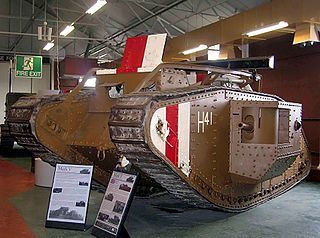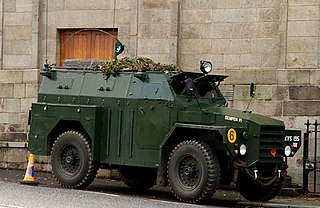
An armoured fighting vehicle or armored fighting vehicle (AFV) is an armed combat vehicle protected by armour, generally combining operational mobility with offensive and defensive capabilities. AFVs can be wheeled or tracked. Examples of AFVs are tanks, armoured cars, assault guns, self-propelled artilleries, infantry fighting vehicles (IFV), and armoured personnel carriers (APC).

A tank destroyer, tank hunter or tank killer is a type of armoured fighting vehicle, predominantly intended for anti-tank duties. They are typically armed with a direct fire artillery gun, also known as a self-propelled anti-tank gun, or missile launcher, also called an anti-tank missile carrier. The vehicles are designed specifically to engage and destroy enemy tanks, often with limited operational capacities.

An infantry fighting vehicle (IFV), also known as a mechanized infantry combat vehicle (MICV), is a type of armoured fighting vehicle used to carry infantry into battle and provide direct-fire support. The 1990 Treaty on Conventional Armed Forces in Europe defines an infantry fighting vehicle as "an armoured combat vehicle which is designed and equipped primarily to transport a combat infantry squad, and which is armed with an integral or organic cannon of at least 20 millimeters calibre and sometimes an antitank missile launcher". IFVs often serve both as the principal weapons system and as the mode of transport for a mechanized infantry unit.

The Wiesel Armoured Weapons Carrier is a German light air-transportable armoured fighting vehicle, more specifically a lightly armoured weapons carrier, produced by Rheinmetall.

Swingfire was a British wire-guided anti-tank missile developed in the 1960s and produced from 1966 until 1993. The name refers to its ability to make a rapid turn of up to ninety degrees after firing to bring it onto the line of the sighting mechanism. This means that the launcher vehicle could be concealed and the operator, using a portable sight, placed at a distance in a more advantageous firing position.

The Malkara was one of the earliest guided anti-tank missiles (ATGMs). It was jointly developed by Australia and the United Kingdom between 1951 and 1954, and was in service from 1958 until gradually replaced by the Vickers Vigilant missile in the late 1960s. It was intended to be light enough to deploy with airborne forces, yet powerful enough to knock out any tank then in service. The basic form was later adapted for the short-range surface-to-air role as the Seacat and influenced the development of the Ikara.

The Humber Pig is a lightly armoured truck used by the British Army from the 1950s until the early 1990s. The Pig saw service with the Royal Ulster Constabulary (RUC) chiefly as an armoured personnel carrier from late 1958 until early 1970. The Pig became particularly well known from its presence on the streets of Northern Ireland during the worst of the Troubles.

The Marmon–Herrington armoured car was a series of armoured vehicles that were produced in South Africa and adopted by the British Army during World War II. They were also issued to RAF armoured car companies, which seem never to have used them in action, making greater use of Rolls-Royce armoured cars and other types.
Orange William was a British project to develop a long-range anti-tank missile as a possible alternative to the Malkara being developed in Australia. The project was drawn up in 1954 and the resulting contract won by Fairey Engineering in 1956. It was very similar to Malkara in form and layout, including the Malkara's distinctive square fuselage. It differed primarily in its guidance system and the use of an infrared command link replacing the Malkara's manual wire guidance. The name is a randomly selected "rainbow code".

The WZ-551 is a Chinese wheeled infantry fighting vehicle family. The name WZ-551 actually covers two families of vehicles with the official designations in the People's Liberation Army (PLA) – Type 90 and Type 92. Over 3,000 WZ-551s are in service with the PLA, where they are used by medium mechanized infantry units.
The British Army made extensive use of a variety of combat vehicles during the Second World War. This article is a summary of those vehicles.

An improvised fighting vehicle is an ad hoc combat vehicle resulting from modified or upgraded civilian or military non-combat vehicle, often constructed and employed by civilian insurgents, terrorists, rebels, mobsters, guerrillas, partisans, drug cartels, criminal organizations or other forms of non-state militias and irregular armies. Such modifications usually consist of grafting improvised armour plating and fixed crew-served weapons such as heavy machine guns or antiaircraft autocannons mounted onto the back of a utility vehicle or pickup truck.
FNSS Savunma Sistemleri A.Ş. is a Turkish defense manufacturer founded in 1988. It is owned 51% by Nurol Holding of Turkey and 49% by British–American firm BAE Systems Inc., and operates facilities located in Gölbaşı, Ankara.

A missile vehicle, also known as a missile carrier, missile truck, or missile launcher vehicle, is a military vehicle that is purpose-built and designed to carry missiles, either for safe transportation or for launching missiles in combat. Missile vehicles include transporter erector launchers (TEL) and multiple rocket launchers (MRL).












